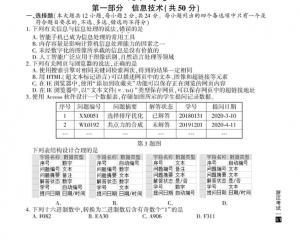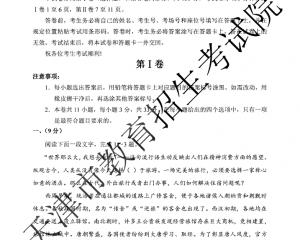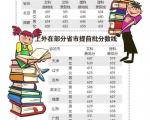教育公平是社會公平的重要基礎,促進教育公平是國家基本教育政策。黨和國家高度重視家庭經濟困難學生上學問題,近些年中央有關部門密集出臺相關資助政策措施,已建立起覆蓋學前教育至研究生教育的學生資助政策體系,從制度上保障不讓一個學生因家庭經濟困難而失學。
Educationalequitymatters because it is an important basis for social equality, and the basic education policy in China is to ensure greater equity in education for all. The Chinese government is committed to increasing the affordability and availability of education for low-income students. And competent authorities over recent years have introduced a series of financial aid policies and put into place a financial aid system that runs from preschool education to graduate education, to institutionally ensure the affordability of education for low-income students.
一、 高等教育學生資助政策
A. Financial Aid for Students in Higher Education
(一)本專科生教育階段:國家獎助學金、國家助學貸款、學費補償貸款代償、校內獎助學金、勤工助學、困難補助、伙食補貼、學費減免、“綠色通道”等多種方式的混合資助體系
1. Undergraduate students and junior college students have access to national scholarships and grants, national student loans, tuition and loan compensation, on-campus scholarships and grants, work-study, living allowances, food stipends, tuition reduction programs and Green Channels.
1.國家獎學金。本專科生國家獎學金,用于獎勵特別優秀的全日制普通高校本專科(含高職、第二學士學位)在校生,每年獎勵本專科學生5萬名,每生每年8000元。
1.1 National Scholarships
National scholarships are awarded to full-time undergraduates and junior college students, including those studying in vocational colleges or seeking a second bachelor’s degree. They are offered to 50,000 applicants across the country per year, and each eligible student will receive RMB 8,000 per year.
2.國家勵志獎學金。用于獎勵資助品學兼優、家庭經濟困難的全日制普通高校本專科(含高職、第二學士學位)在校生。國家勵志獎學金資助面約為全國全日制普通高校本專科(含高職、第二學士學位)在校學生總數的3%,每生每年5000元。同一學年內,國家勵志獎學金和國家獎學金不能同時獲得。
1.2 National Endeavor Fellowships
National Endeavor Fellowships are open to 3% of full-time undergraduates and junior college students, including those in vocational colleges or seeking a second bachelor’s degree, who are with extraordinary financial need and outstanding academic performance. Each eligible student will receive RMB 5,000 per year and cannot apply for national scholarships in the same academic year.
3.國家助學金。用于資助家庭經濟困難的全日制普通高校本專科(含高職、第二學士學位)學生,國家助學金資助面約為全國全日制普通高校本專科(含高職、第二學士學位)在校學生總數的20%,平均資助標準為每生每年3000元,可分設2-3檔。
1.3 National Grants
National grants are offered to 20% of full-time undergraduates and junior college students, including those studying in vocational colleges or seeking a second bachelor’s degree, who come from low-income families. Each eligible student will receive RMB 3,000 on average per year.
4.國家助學貸款。國家助學貸款是由政府主導,金融機構向高校家庭經濟困難學生提供的不需要擔保或抵押的信用助學貸款,幫助解決在校期間的學費和住宿費用,每學年貸款金額原則上不超過8000元,貸款期限最長不超過20年。國家助學貸款利率執行中國人民銀行同期公布的同檔次基準利率,不上浮。貸款學生在校期間的貸款利息全部由財政貼息,畢業后的利息由學生支付,并按約定償還本金。家庭經濟困難學生申請國家助學貸款,有兩種模式:一是校園地國家助學貸款,即通過就讀學校向經辦銀行申請;二是生源地信用助學貸款,即通過戶籍所在縣(市、區)的學生資助管理機構提出申請(有的地區直接到相關金融機構申請)。
1.4 National Student Loans
National student loans are a government-led program in which financial institutions provide loans to low-income students without requiring any collateral, to help them pay tuition and accommodation fees. In principle each eligible student can borrow no more than RMB 8,000 per year, and the loans and interests must be repaid in less than 20 years. Interest rates for the loans are determined by the benchmark interest rates published by the People’s Bank of China at the time of loan issuance, depending on term length. They are fixed for the life of the loan.The government pays the interest for the students while enrolled in school, and after leaving school, the students need to pay the interest and principal in a manner as agreed with the banks.There are two types of national student loans: 1) university-based loans issued by banks in the region where the university is located, and 2) home-based loans issued by banks in the region where the student’ s residence is officially registered. To apply for either of the loans, low-income students can submit paperwork to their universities, to local student loan authorities, and in some regions, to financial institutions directly.
5.基層就業學費補償貸款代償。對中央部門所屬全日制普通高等學校應屆畢業生,自愿到中西部地區和艱苦邊遠地區基層單位就業、服務期達到3年以上(含3年)的,實施學費補償或國家助學貸款代償。補償代償金額根據畢業生在校期間每年實際繳納的學費或獲得的國家助學貸款確定,每生每年不高于8000元。每年補償或代償總額的1/3,分3年補償代償完畢。地方高校畢業生學費補償貸款代償由各地參照中央政策制定執行。
1.5 Tuition and Loan Compensation for Community Workers
The compensation program is available to full-time college students from universities directly administered by ministries, who volunteer to work at community levels in remote and underdeveloped regions in central and western China for at least three consecutive years. The amount of compensation is determined by the tuition fees or loans that eligible students have paid or received, and can reach up to RMB 8,000 per year. The tuition fees and loans are compensated in a period of three years - one third of the total every year. In local universities, details of the program are determined by local authorities in accordance with policies of the central government.
6.應征入伍服義務兵役學費補償貸款代償及學費減免。對應征入伍服義務兵役的高等學校在校生及畢業生在校期間繳納的學費或獲得的國家助學貸款實施一次性補償或代償,對退役后復學的高校在校生(含高校新生)實行學費減免。補償代償金額根據學生在校期間每年實際繳納的學費或獲得的國家助學貸款確定,退役復學學費減免金額按照實際收取學費確定,每生每年均不高于8000元。
1.6 Tuition and Loan Compensation& Tuition Reduction for Enlisted Soldiers
The program is offered to college students drafted into military service and provides one-time compensation for their tuition fees or national student loans. If they return to college after retirement from service, the students, including freshmen, are qualified for tuition reduction. The amount of compensation is determined by the tuition fees or loans that the students have paid or received while enrolled in school. Each returning student will receive up to RMB 8,000 per year in reduced tuition fees.
7.直招士官學費補償貸款代償。對直接招收為士官的高等學校學生,入伍時對其在校期間繳納的學費實行一次性補償或對其獲得的國家助學貸款實行代償,補償代償金額根據畢業生在校期間每年實際繳納的學費或獲得的國家助學貸款確定,每生每年不高于8000元。
1.7 Tuition and Loan Compensation for Junior Military Officers
The one-time compensation scheme is open to college students enlisted as junior military officers. The amount of compensation is determined by the tuition fees or national student loans that the students have paid or the national student loans that they have received while enrolled in school. Each eligible student will receive up to RMB 8,000 per year in compensated tuition fees or loans.
8.師范生免費教育。在北京師范大學、華東師范大學、東北師范大學、華中師范大學、陜西師范大學和西南大學六所教育部直屬師范大學實行師范生免費教育。免費教育師范生在校學習期間,免除學費、免繳住宿費,并補助生活費。地方師范院校師范生資助由各地自行實施。享受師范生免費教育的學生可以申請國家獎學金,但不能申請國家勵志獎學金和國家助學金。
1.8Free Education for Future Teachers
Free educationis available to students in Beijing Normal University, East China Normal University, Northeast Normal University, Central China Normal University, Shaanxi Normal University and Southwest University, all of which are directly administered by the Ministry of Education. Students under teacher training programs will be exempted from tuition and accommodation fees and provided with living allowances. Details of the program for other teachers’ universities at local levels determined by local authorities. Eligible students can apply for national scholarships, but not national endeavor fellowships or national grants.
9.退役士兵教育資助。對退役一年以上、考入全日制普通高等學校的自主就業退役士兵,給予教育資助。內容:一是學費資助;二是家庭經濟困難退役士兵學生生活費資助;三是其他獎助學金資助。學費資助標準,按省級人民政府制定的學費標準,每學年每生最高不超過8000元。生活費及其他獎助學金資助標準,按國家現行高校學生資助政策的有關規定執行。
1.9 Education Grants for Retired Soldiers
The grants are available to self-employed soldiers who have retired from active service for at least one year and been admitted as full-time college students. They consist of1) tuition grants which can reach up to RMB 8,000 per year based on tuition rates set by provincial governments, and 2) living allowances for low-income soldiers, and 3) scholarships and grants in other forms.The latter two are provided in a manner consistent with relevant national regulations of grants for college students.
10.新生入學資助項目。從2012年起,對中西部地區啟動高校家庭經濟困難新生入學資助項目,用于解決學生家庭至錄取學校間的路費及入校后短期生活費,省(區、市)內院校錄取的新生每人資助500元,省(區、市)外院校錄取的新生每人資助1000元。
1.10 Freshman Grants
Freshman grants are offered to low-income admittedcollege students from central and western China, to help them travel to colleges for registration and pay for college living expenses in the short term. Each eligible student will receive RMB 500 when admitted to a university located in the province where the student resides, and RMB 1,000 when admitted to a university in a different province.
11.勤工助學。學校設置校內勤工助學崗位,并為學生提供校外勤工助學機會。家庭經濟困難學生優先考慮。學生參加勤工助學原則上每周不超過8小時,每月不超過40小時,勞動報酬原則上不低于當地政府或有關部門制定的最低工資標準或居民最低生活保障標準。
1.11 Work-study
Work-study programs provide on-campus part-time jobs and off-campus part-time job opportunities to all students, with a particular focus on those from low-income families. In principle students under these programs work for no more than 8 hours a week, or no more than 40 hours a month. And in principle their compensation will be no less than local minimum wage standards or subsistence allowances.
12.校內資助。學校利用從事業收入中提取的資助資金以及社會團體、企事業單位和個人捐助資金等,設立校內獎學金、助學金、困難補助、伙食補貼、校內無息借款、減免學費等。
1.12 School Programs
School programs consist of scholarships, grants, living allowances, food stipends, interest-free loans and tuition reduction programs. They are funded by contributions from universities and donations from non-government organizations, businesses, public institutions and individuals.
13.綠色通道。全日制普通高校建立“綠色通道”,對被錄取入學、無法繳納學費的家庭經濟困難新生,先辦理入學手續,然后再根據學生實際情況,分別采取不同辦法予以資助。
1.13 Green Channels
Green channels are available to admitted full-time students who cannot afford tuition fees. Under the scheme, eligible students can register as scheduled and will be provided with financial support based on their financial need.
(二)研究生教育階段:國家獎助學金、“三助”崗位津貼、國家助學貸款、學費補償貸款代償等多種方式并舉
2Graduate students have access to national scholarships and grants, on-campus part-time job allowances, national student loans, and tuition and loan compensation programs.
1.國家獎學金。研究生國家獎學金用于獎勵特別優秀的研究生。每年獎勵4.5萬名,其中碩士生3.5萬名、每生每年2萬元,博士生1萬名、每生每年3萬元。
2.1 National Scholarships
National scholarships are awarded to graduate students with a record of strong academic achievement. They are offered to 35,000 master's degree students - RMB 20,000 each per year, and 10,000 doctoral students - RMB 30,000 each per year.
2.學業獎學金。為激勵研究生勤奮學習、潛心科研、勇于創新、積極進取而設立的獎學金。中央高校根據研究生收費標準、學業成績、科研成果、社會服務以及家庭經濟狀況等因素,確定研究生學業獎學金的覆蓋面、等級、獎勵標準和評定辦法(可分檔設定獎勵標準)。研究生學業獎學金標準不得超過同階段研究生國家獎學金標準的60%。地方高校研究生學業獎學金政策由各地參照中央政策制定執行。
2.2 Academic Excellence Scholarships
Academic Excellence Scholarshipsare designed to boostgraduate students’ commitment to academic research, innovation and excellence. In universities directly administered by ministries, the coverage, size and implementation of the scholarships are determined by a wide range of criteria, including tuition fees, academic achievement, research performance, community services and financial background of the candidates. The amount of scholarships can reach up to 60% of national scholarships for graduates. The scholarships in local universities are implemented in accordance with policies of the central government.
3.國家助學金。用于資助全國普通高等學校納入全國研究生招生計劃的所有全日制研究生(有固定工資收入的除外)的基本生活支出。碩士研究生資助標準不低于每生每年6000元,博士研究生資助標準不低于每生每年10000元。
2.3 National Grants
National grants are offered to full-time graduate students (exepct those formally employed) to help them pay college living expenses. Each eligible graduate student will receive no less than RMB 6,000, and each eligible doctoral student no less than RMB 10,000 per year.
4.“三助”崗位津貼。高等學校利用教育撥款、科研經費、學費收入、社會捐助等資金,設置研究生“三助”(助研、助教、助管)崗位,并提供“三助”津貼。原則上,助研津貼主要通過科研項目經費中的勞務費及科研間接費列支,助教津貼和助管津貼所需資金由高等學校承擔。研究生“三助”津貼標準由高校依據國家有關規定,結合當地物價水平等因素合理確定。
2.4 On-Campus Part-Time Job Allowances
The allowance scheme is funded by educational appropriations, research revenue, tuition fees of the university, as well as public donations. It is available to students who work as research assistants, teaching assistants and administrative assistants on campus. In principle allowances for research assistants are offered as labor costs and indirect research spending, and those for teaching assistants and administrative assistants are borne by the university. The amount of allowances is determined by the university in accordance with national regulations and local price levels.
5.國家助學貸款。研究生申請國家助學貸款的條件、程序及其他有關規定,與高校本專科生國家助學貸款基本相同。原則上,研究生助學貸款以校園地國家助學貸款為主,每學年每生貸款金額不超過12000元。
2.5 National Student Loans
National student loans for graduate students are offered in the same manner as those for undergraduates and junior college students. In principle the loans are university-based, and each eligible student can borrow no more than RMB 12,000 per year.
6.基層就業學費補償貸款代償。應屆畢業研究生赴基層就業申請學費補償貸款代償的條件、程序及相關規定,與本專科畢業生基本相同。研究生補償代償金額每生每年不高于12000元。
2.6 Tuition and Loan Compensation for Community Workers
The compensation program is operated in the same manner as that for undergraduates and junior college students. Each eligible student will receive up to RMB 12,000 per year in compensated tuition and loan.
7.應征入伍服義務兵役學費補償貸款代償及學費減免。研究生應征入伍服義務兵役申請學費補償貸款代償及學費減免的條件、程序及相關規定,與本專科生基本相同。研究生補償代償或學費減免金額每生每年不高于12000元。
2.7 Tuition and Loan Compensation& Tuition Reduction for Enlisted Soldiers
The programs is run in the same manner as that for undergraduates and junior college students. Each eligible student will receive up to RMB 12,000 per year in compensated loans or reduced tuition fees.
8.直招士官學費補償貸款代償。對直接招收為士官的研究生,其申請學費補償貸款代償的條件、程序及相關規定,與本專科生基本相同。研究生補償代償金額每生每年不高于12000元。
2.8 Tuition and Loan Compensation for Junior Military Officers
The compensation scheme is operated in the same manner as that for undergraduates and junior college students. Each eligible student will receive up to RMB 12,000 per year in compensated tuition fees and loans.
9.退役士兵教育資助。對退役一年以上、考入普通高等學校并納入全國全日制研究生招生計劃的自主就業退役士兵,給予教育資助。資助內容與本專科生基本相同。學費資助標準每學年每生最高不超過12000元。
2.9 Education Grants for Retired Soldiers
The grantsare available to self-employed soldiers who have retired from active service for at least one year and been admitted as full-time college students under master’s degree programs. The grants are provided in the same manner as those for undergraduates and junior college students, and each eligible students will receive up to RMB 12,000 per year in tuition grants.
二、中等職業教育學生資助政策
B.Financial Aid for Students in Secondary Vocational Education
建立起以國家免學費、國家助學金為主,學校和社會資助及頂崗實習等為補充的學生資助政策體系。
Financial aid for students in secondary vocational education includes tuition exemption and national scholarships, supported by contributions by schools, donations of non-governmental organizations and internship programs.
1.免學費
國家對中等職業學校全日制正式學籍一、二、三年級在校生中所有農村(含縣鎮)學生、城市涉農專業學生和家庭經濟困難學生、藝術類戲曲表演專業學生免除學費(藝術類其他表演專業學生除外)。
1 Tuition Exemption
The tuition exemption scheme is offered to full-time first, second and third graders in secondary vocational schools. Eligible applicants are 1) rural students, including those from towns and counties, 2) urban students who come from low-income families or major in agriculture and related disciplines, and 3) students of traditional Chinese operas, and students of other performing arts are not qualified for the scheme.
對民辦中等職業學校符合免學費條件的學生,按照當地相同類型同專業公辦中等職業學校免學費標準給予補助。學費標準高出公辦學校免學費標準部分由學生家庭負擔;低于公辦學校免學費標準的,按照民辦學校實際學費標準予以補助。
The scheme is also open to eligible students in private schools. They will receive compensation to balance out tuition fees. When their tuition fees exceed those in public schools, the students will pay for the balance.
2.國家助學金
國家助學金資助對象為全日制正式學籍一、二年級在校涉農專業學生和非涉農專業家庭經濟困難學生,資助標準生均每年2000元。
2 National Grants
National grants are available to full-time first and second graders who major in agriculture and related disciplines or come from low-income families. Each eligible student will receive an average RMB 2,000 per year.
家庭經濟困難學生比例按區域確定,六盤山區等11個連片特困地區和西藏、四省藏區、新疆南疆三地州中等職業學校農村學生(不含縣城)全部納入享受助學金范圍。
The share of low-income students in the recipients varies by region. National grants are offered to all rural students in schools in eleven regions where the extremely poor population concentrates; in the Tibet autonomous region; in Tibetan communities in Qinghai, Sichuan, Yunnan and Gansu provinces; and in Kashgar, Khotan and Kizilsu Kirghiz in Xinjiang.
地方出臺的中等職業教育免學費政策和助學金政策,范圍大于或相關標準高于國家標準的,可按照本地的辦法繼續實施。
Tuition exemption and grant policies introduced by local governments, which may have a larger coverage or provide more grants than those by the central government, can be introduced and continued based on local realities.
3.頂崗實習
安排中等職業學校三年級學生到企業等單位頂崗實習,獲得一定報酬,用于支付學習和生活費用。
3 Internships
Third graders can work as full-time interns in companies and get paid based on performance to pay studying and living expenses.
4.獎學金
地方政府、相關行業、企業安排專項資金設立中職學生獎學金。
4 Scholarships
Local governments, industries and business can provide scholarship programs for students in secondary vocational schools.
5.學校免學費等
中等職業學校每年安排一定的經費,用于國家免學費政策之外的學費減免、勤工助學、校內獎學金和特殊困難補助等。
5 School Programs
Every year theschools leverage their financial resources to offer tuition reduction, work-study, scholarships and living allowances on top of the state-run tuition exemption program.
6.其他資助
鼓勵和支持社會團體、企事業單位以及個人資助中職學校家庭經濟困難學生。
6 Others
Non-governmental organizations, public institutions and businesses and individuals are encouraged to provide financial support to low-income students in secondary vocational schools.
三、普通高中教育學生資助政策
C. Financial Aid for Students in Senior High Education
建立起以政府為主導,社會力量積極參與的普通高中家庭經濟困難學生資助政策體系。
Financialaid for students in senior high school education is a system led by the government and supported by wider public participation.
1.免除學雜費。從2016年秋季學期起,免除公辦普通高中建檔立卡家庭經濟困難學生,包括非建檔立卡家庭經濟困難殘疾學生的學雜費,對民辦學校符合條件的學生,按照當地同類型公辦學校標準給予補助。
1 Exemption of Tuition and Miscellaneous Fees
From the autumn semester in 2016, officially registered low-income students, including unregistered ones living with disabilities, are qualified for exemption of tuition and miscellaneous fees in public senior high schools. Eligible students in private schools receive the same level of compensation as in public schools.
2.國家助學金。用于資助普通高中在校生中的家庭經濟困難學生,資助面約占全國普通高中在校生總數的20%,平均資助標準為每生每年2000元,具體標準由各地結合實際分檔確定。
2 National Grants
National grants are offered to 20% of senior high school students, who come from low-income families. Each eligible student will receive an average RMB 2,000 per year. Details of the scholarships are determined by local authorities based on their realities.
3.學校資助。學校從事業收入中提取一定比例的經費,用于減免學費、設立校內獎助學金和特殊困難補助等支出。
3. School Programs
The grants take the form of tuition reduction, scholarships and special living allowances offered by the schools.
4.社會資助。積極引導和鼓勵企業、社會團體及個人等面向普通高中設立獎學金、助學金。
4. Private Programs
Non-governmental organizations, businesses and individuals are encouraged to provide scholarships and grants in senior high schools.
四、義務教育學生資助政策
D. FinancialAid for Students in Compulsory Education
全面免除城鄉義務教育階段學生學雜費、免費提供教科書,對家庭經濟困難寄宿生提供生活補助,實施營養改善計劃。
Financial aid for students in compulsory education consists of exemption of tuitionand miscellaneous fees, free textbooks, living allowances for low-income resident students and nutrition improvement plans.
1.免學雜費。全部免除城鄉義務教育階段所有學生學雜費。
1 Exemption of Tuition and Miscellaneous Fees
All rural and urban students in compulsory education are exempted from tuition and miscellaneous fees.
2.免費教科書。對義務教育階段所有學生免費提供教科書。免費教科書資金,國家規定課程由中央全額承擔,地方課程由地方承擔。同時國家為小學一年級新生免費提供正版學生字典,所需資金由中央財政全額承擔。
2 Free Textbooks
All the students in compulsory education are provided with free textbooks. Textbooks of nationally designed courses are funded by the central government, while those for locally designed ones are funded by local governments. In addition, first graders in elementary schools are provided with free dictionaries funded by the central government.
3.寄宿生生活補助。城鄉家庭經濟困難寄宿生可以享受寄宿生生活費補助。補助標準為小學生每生每年1000元、初中生每生每年1250元。
3 Living Allowances for Resident Students
The allowances are available to low-income resident students from both rural and urban areas. Students in elementary schools will receive RMB 1,000 and students in junior high schools RMB 1,250, per year.
4.營養改善計劃。國家實施農村義務教育學生營養改善計劃。中央財政為國家試點地區農村義務教育階段學生提供營養膳食補助,補助形式為向學生提供等值優質食品,不以現金形式直接發放。補助標準為每生每年800元。
4 Nutrition Improvement Plans
The state-run plans are targeted at students in compulsory education in rural areas. The central government now provides each student with nutrition-rich food worth RMB 800 per year under pilot programs.
五、學前教育資助政策
E. Financial Aid for Students in Pre-School Education
按照“地方先行、中央補助”的原則,各地建立學前教育資助政策體系。
The financial aid system for pre-school education leverages local financial resources and is supplemented by fiscal support from the central government.
1.政府資助。地方政府對經縣級以上教育行政部門審批設立的普惠性幼兒園在園家庭經濟困難兒童、孤兒和殘疾兒童予以資助。中央財政根據地方出臺的資助政策、經費投入及實施效果等因素,予以獎補。
1 GovernmentGrants
Local governments provide grants to low-income students, orphans and students living with disabilities in public kindergartens and private kindergartens for social welfare purposes. At the same time the central government offers awards and subsidies to the schools, in line with local policies and based on the performance of government expenditure.
2.幼兒園資助。幼兒園從事業收入中提取一定比例的經費,用于減免收費、提供特殊困難補助等,具體比例由各地自行確定。
2 School Grants
Kindergartens allocate a certain percentage of their revenues as grants that take the form of tuition reduction programs and special living allowances. The percentage rate is determined by local authorities.
3.社會資助。各地建立和完善相關優惠政策,積極引導和鼓勵社會團體、企事業單位及個人等捐資,幫助家庭經濟困難兒童、孤兒和殘疾兒童接受普惠性學前教育。
3 Private Programs
With strengthened policies measures, non-governmental organizations, public institutions and businesses and individuals are encouraged to increase financial support to expand access to pre-school education for poor and orphaned children and those living with disabilities.
更多精彩資訊請關注查字典資訊網,我們將持續為您更新最新資訊!
 2020浙江高考技術真題及答案2020-08-20
2020浙江高考技術真題及答案2020-08-20 2020天津高考語文真題及答案2020-08-20
2020天津高考語文真題及答案2020-08-20 專家:建議中考高考,男生實行加20分政策2020-08-13
專家:建議中考高考,男生實行加20分政策2020-08-13 2020年河北省普通高考考生填報志愿咨詢方式-查字典資訊網2020-08-04
2020年河北省普通高考考生填報志愿咨詢方式-查字典資訊網2020-08-04 2020河北高考分數線公布-查字典資訊網2020-08-04
2020河北高考分數線公布-查字典資訊網2020-08-04